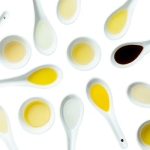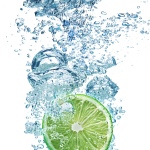
With all the heart healthy press out there today, cooking oils have been a major topic of discussion. You may not have noticed but, cooking oils play a major role in our overall health. If you think cooking oils are not a big thing, understand that Americans digest five hundred and seventy six ounces of cooking oil a year! If you’re counting those calories, that amounts to more than four hundred calories each day!
With that in mind and knowing that we would be using a lot of oils in our dishes, I set about to find the right oils for our use. Fortunately, although there are many oils available on the market today, there is also a multitude of articles on the properties of each. My first stop, as always, was a visit to my nutritionist. She has been invaluable in assisting me on keeping all our cakes sold around the world and dishes offered at our international bistro as healthy as possible. And she jumped right in to our healthy versus unhealthy oil discussion.
Before we got into the discussion of the types of oil, she explained that I needed to know about fatty profiles. Every oil has one and that is the basis of how you determine how healthy each oil is. An oil’s fatty profile includes; unsaturated fats, mono-unsaturated fats and poly-unsaturated fats as well as medium chain triglycerides. All should play a part in the oil you choose.
We discussed every oil that is commonly used and the benefits and negatives to each. Armed with this knowledge, I set about to make sure all our offerings were matched to the proper oil and only healthy, environmentally friendly oils were used.
To use my own variation on a Thornton Wilder quote “Knowledge is like manure; it’s not worth a thing unless it’s spread around shared, encouraging all minds to grow.” And so, let’s take a trip down the slippery slope of oil to look at each of the most popular oils consumed by Americans today and find out what’s in their health profile.
I’ll start with the most popular oils and work my way down the list.
Vegetable Oil – Don’t be fooled by this term.The term “vegetable oil” can be used as a generic term for all plant-based oils and that includes oils with trans fats, which unless you’ve been living under a rock for the last twenty years, you are well aware is absolutely unhealthy for you. The moral here, just because it says “vegetable oil”, doesn’t mean it’s healthy. Stay away from vegetable oils and focus in on specific oil names.
Canola Oil – Because Canola oil is high in monounsaturated fats and antioxidants it’s a good anti-inflammatory oil. Canola oil is also a great oil to use when you’re cooking especially when using high-temperatures (for the purposes of oils, high temperatures starts at 410° and is referred to as the “smoke point”. Above that temperature, many oils begin to smoke and burn). So now you feel great because you always use canola oil, right. Well, read on because there are some REALLY good alternatives that may change your mind.
Olive Oil – Like Canola oil, “un-refined extra virgin” olive oil is high in monounsaturated fats and antioxidants which makes it a good anti-inflammatory oil. In addition, olive oil is also high in oleic acid which has been shown to reduce heart disease, diabetes, obesity and high blood pressure. This makes “un-refined extra virgin” olive oil one of the best oils you can consume. When I’m talking olive oil, please note that I’m referring to “un-refined extra virgin” olive oil? Refined olive oils lack the important antioxidants and anti-inflammatories that make extra-virgin un-refined olive oil so special. Olive oil is not a good oil for high temperature cooking, as it has a low smoke point but, olive oil has one of the best taste profiles. of all the oils. Because of this, use your “un-refined extra virgin” olive oil on salads, dressings and for dipping that great Italian bread.
Peanut Oil – Peanut oil is also high in monounsaturated fats and antioxidants, and as such, is a good anti-inflammatory. As with canola oil, peanut oil is excellent for high-temperature cooking. Peanut oil can be purchased with a mild, almost neutral taste, as well as with a strong peanut flavor. Neutral tasting peanut oil is a favorite cooking oil for many chef’s.
Corn Oil, Grape Seed Oil & Sunflower Oil: Corn, sunflower and grape seed oil’s contain high levels of omega-6 polyunsaturated fats and decent amounts of monounsaturated fats. Omega 6 has been shown to lower blood cholesterol and support the skin. Corn oil and grape seed oil are both good for cooking because of their high smoke point, however, sunflower oil has a relatively low smoke point and should be used instead for low heat cooking or dressings..
Sesame Oil, Walnut Oil & Pistachio Oil – These oils are some of the best sources of monounsaturated fat, anti-inflammatories and antioxidants. Recent tests have also shown that monounsaturated fats help reduce cholesterol.” Great oils to consume but, all of these oils have a low smoke point, so keep them away from higher temperatures.
Palm Oil: Being a fan of sustainable farming and environmentally sound issues, I can’t in good conscience recommend palm oil. Palm oil is one of the worst offenders of the environment. Palm tree farms, created for the sole purpose of producing palm oil, are springing up throughout Indonesia and the Amazon, These neat rows of thousands of palm trees displace the natural habitats and kill off the animals living in those habitats. In addition, the forest areas they replace are one of the key protectors of climate change. Unfortunately, because it is so cheap to produce, palm oil is found in many products. If, heaven forbid, you don’t care about the environment, you need to know, for a healthy body, palm oils health status is atrocious. Palm oil is extremely high in saturated fat which, should be reason enough to cross it off your list of potential oils.
Coconut Oil – Coconut Oil has a high amount of medium chain triglycerides which, are good for you, if you have an issue with absorbing fats. It has been the favorite child of health advocates for the last several years BUT, its high saturated fat content is subject to scrutiny because high levels of saturated fat have been linked to an increase in total cholesterol. Because of this, and the fact that there are so many alternative oils that don’t pose this risk, I personally stay away from the use of coconut oil.
Flaxseed Oil, Hemp Seed Oil & Pumpkin Seed Oil – I’ve lumped these three oils together because they are so similar in composition. Each of these oils contain healthy amounts of monounsaturated fats but also, relatively high amounts of omega-3 fatty acids derived from plant-sources. For those of you who are not aware of the benefits of omega-3 fatty acids, they have been shown to decrease inflammation (a major source of a multitude of human ailments) and control blood pressure levels. Because of this, these three oils are some of the healthiest oils you can consume. Since all three of these oils have low smoke points, they all make a poor choice for cooking on your range or oven.
Avocado Oil – I’ve saved the best for last. Like “un-refined extra virgin” Olive oil, avocado oil is extremely high in oleic acid which protects you against heart disease, diabetes, obesity, and high blood pressure. Although olive oil has the best flavor profile of all the oils, because avocado oil offers the same oleic acid benefits, robust anti-inflammatory qualities AND has a relatively high smoke point, it should be your every day oil of choice.
So now you have it. Sixteen of the most popular oils, laid out for you, showing what each has to offer. Pick the ones that work best for you and dump the ones that are unhealthy.
My pick…. “save your “un-refined extra virgin” olive oil for your dressings, dips, spreads and marinades and choose your avocado oil for all your cooking”.
